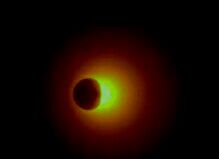Main

Introduction
States?

Introduction
Can we see it?
Where is it?
What is it?
Hot vs. Cold?

Introduction
What is it?
And Einstein?
Where is it?
Cosmic bias?
Conclusion
Authors
Bibliography
|

This is a complex question because the answer is both yes and no. We can not "see" it with our eyes, or any telescope for that matter. However, we can measure its effect on nearby objects and deduce its presence. For instance, we could watch a nearby star and notice a predictable wobble. Thus, we could deduce that a "dark" planet orbits the star. This same concept can be applied to entire galaxies. We can infer the presence of dark matter because it accounts for otherwise baffling movements of stars within those galaxies.

|
|
You can see here that the star is wobbling predictably in its path. With the technology we have, we cannot "see" exactly what is causing this space-time distortion. Pay particular attention to when the star appears to jerk (about half-way through a cycle). It is as if the star is modifying its spin direction. But what could cause this? We can't "see" anything there.
Now move your mouse into the box containing the wobbling star.
Using various equations derived from quantum mechanics (the theory of atomic behavior), special relativity (the physical theory of space and time developed by Albert Einstein), and general cosmology, we can infer that a "dark" object is orbiting the star--and here it appears a "dark" Tim is in orbit. The size of the object cannot truly be identified because we are unaware of the composition of the "dark" object; however the path can be approximated. Notice when the star jerks, "dark" Tim is nearest to the star, thereby causing the predictable wobble. (Please note: the amount of wobble is extremely exaggerated, as is the time between occurrences. But then again, a slimy moose is gaily zipping around a star--does anything else really matter?)
|
On a larger scale, the same technique can be applied to entire galaxies. When we observe the orbits of stars and gas clouds as they circle the centers of spiral galaxies, we calculate that they are moving entirely too fast. The velocity measurements indicate that large amounts of "dark" matter must exist to exhibit the huge gravitational tug that propels these objects around the galactic hub at such a high velocity. Moreover, it can be concluded that the dark matter is spread beyond (and bulges above) the visible boundaries of galaxies.
|
To the right, a galaxy. Move your mouse over the galaxy to see an estimated bulge boundry of "dark" matter. Notice how the bulge extends far beyond the edges of the galaxy. Remember, it is estimated that in this galaxy, up to 90% of the gravatational mass is "dark" matter.
|

|
X-ray astronomers have discovered that clusters of galaxies drift within vastly diffused and extraordinarily hot (about 100,000,000 degrees) gas. The high-energy gas can offer evidence to the nature, location, and distribution of the "dark" matter. Most importantly, when we add the x-ray emitting hot gas and the visible matter, we are able to identify roughly 10 to 30 percent of the clusters total gravitational mass. The 70 to 90 percent surplus, therefore, must be "dark" matter!
Another method of detection has recently emerged. The great frizzy-haired Albert Einstein developed a concept known as gravitational lensing. This "lensing" occurs when gravity from a massive object bends the light of another object that passes near it. For example, when a galaxy (or cluster of galaxies) obstructs our view of another galaxy behind it, the closer galaxy warps the more distant galaxies light. Rings or arcs of light, depending on the geometry involved, are then produced. Dense objects in our own galaxy can gravitationally lens light. If a foreground object eclipses a background star, the light from the background star becomes distorted into a tiny ring, whose brightness greatly exceeds the star's typical brightness. A detailed examination of the light's variations can disclose the mass of the dark foreground object.

|
What Einstein was talking about: A ring of light on the left side of the object, and an arc on the right are clearly visible.
|
|









